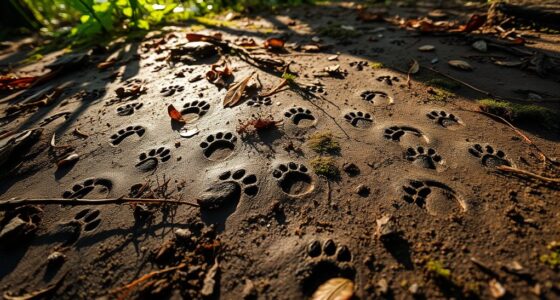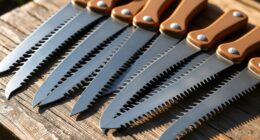To start a fire with foraged materials, first identify dry, fibrous plants, bark, seed heads, or moss as tinder, and gather lightweight, dry twigs or pine needles for kindling. Prepare these by shredding or breaking into small pieces to increase surface area. Use a reliable ignition source like a ferro rod, then gently nurture the flame as it catches. Proper technique, safety, and environmental awareness help make certain of success—continue exploring to master this essential skill.
Key Takeaways
- Identify and collect dry, fibrous plants, bark, seed heads, and dried grasses as effective tinder and kindling sources.
- Properly prepare tinder by shredding into small, loose pieces to maximize surface area and airflow.
- Use reliable ignition methods like ferro rods or flint strikers with gentle, consistent strikes.
- Build fires in safe, clear areas away from overhanging branches and dry vegetation, ensuring good control and safety.
- Fully extinguish fires with water or dirt, ensuring no smoldering remains to prevent accidental re-ignition.
Identifying and Gathering Natural Tinder

To start a fire successfully, you first need to identify and gather natural tinder—materials that ignite easily and sustain a flame. Botanical identification is vital here; you want to select dry, fibrous plants, bark, or seed heads that catch fire quickly. Focus on materials like dried grasses, moss, or dead plant fibers, but make sure you’re certain of their plant type before gathering. Ethical foraging means collecting responsibly, without damaging the environment or depleting local resources. Avoid stripping entire plants; instead, take only what’s necessary and leave enough for the ecosystem to thrive. Proper identification and responsible gathering ensure you have effective tinder while respecting nature’s balance. This careful approach makes your fire-starting efforts more successful and sustainable. Additionally, understanding the flammability of natural materials can greatly improve your success rate when starting a fire in the wild.
Types of Easy-to-Ignite Kindling Materials

When choosing kindling materials that ignite easily, you want to focus on lightweight, dry, and fibrous substances that catch fire quickly and help build a stable flame. Many fire starting myths suggest complex methods, but historically, simple materials like dry grass, bark, pine needles, and small twigs have been reliable. These easy-to-ignite kinds of fuel were used in ancient fire methods, proving their effectiveness over time. Natural materials such as cedar shavings, bark strips, and dried leaves burn fast and help sustain your fire without much effort. Avoid damp or green wood, which resists ignition. Selecting the right kindling ensures your fire starts quickly, giving you a solid foundation for building a larger, steady blaze—just as our ancestors did for millennia. Incorporating expertise in fire-starting can further improve your technique and safety.
Preparing Your Tinder and Kindling for Fire-Starting

Before you attempt to start a fire, it’s vital to properly prepare your tinder and kindling to guarantee reliable ignition. Many fire starting myths suggest that any dry material will ignite easily, but selecting the right type is essential. Historically, fire methods relied on finely shredded plant fibers or charred wood to improve ignition chances. To prepare, break your tinder into small, loose pieces that increase surface area and ensure good airflow. Avoid packing materials tightly, as this can hinder combustion. Dryness is key; gather materials that are free of moisture. Properly prepared tinder and kindling will catch fire more quickly and burn steadily, increasing your chances of success when trying to ignite a fire with natural materials. Additionally, using natural materials that are authentic and well-prepared can significantly boost your fire-starting efficiency.
Techniques for Igniting Natural Tinder and Kindling

Igniting natural tinder and kindling requires a steady and focused approach. First, verify your tinder is dry and finely shredded, maximizing surface area for ignition. Use a reliable fire-starting method like a ferro rod or flint striker, applying a gentle, consistent strike to produce sparks. Avoid common fire starting myths, such as using overly damp materials or relying solely on matches; instead, focus on proper technique and patience. Recognize the cultural significance of fire-starting methods—many traditions emphasize respect and care for the flame. Once sparks land on your tinder, gently nurture the flame, blowing softly to encourage growth. With practice, your ability to ignite natural materials becomes second nature, turning simple tinder into a sustainable fire. Additionally, understanding environmental considerations helps ensure your fire-starting practices are responsible and eco-friendly.
Troubleshooting Common Fire-Starting Challenges

When your fire isn’t catching, damp materials might be the culprit, so try drying them out or using drier tinder. Insufficient airflow can smother your flames—arrange your kindling to maximize oxygen flow. Wet tinder often needs time to dry or alternative dry materials to get your fire going smoothly. Additionally, choosing the right fire-starting materials can significantly improve your success rate.
Damp Materials Dilemmas
Damp materials can be one of the biggest hurdles when starting a fire, but with the right approach, you can still get a flame going. First, avoid rushing; instead, try to dry out your tinder and kindling as much as possible. Using a sharp knife or hatchet, strip off wet outer layers and expose dry inner parts. If you lack dry materials, consider alternative ignition methods like a ferro rod or waterproof matches. Fire safety remains essential—keep your fire contained and never leave it unattended. Here’s a quick guide to help:
| Material Type | How to Dry It | Best Alternative Ignition |
|---|---|---|
| Tinder | Wind or sun | Ferro rod |
| Small Kindling | Use a knife to scrape dry inner layers | Waterproof matches |
| Larger Wood | Split and dry exposed wood | Spark lighter |
| Leaves | Collect dry leaves from sheltered spot | Firesteel |
| Bark | Peel and dry inner bark | Lighter or matches |
Additionally, knowing fire-starting techniques can improve your chances of success even when materials are damp.
Insufficient Airflow Issues
Insufficient airflow is a common obstacle when trying to get a fire going, especially in crowded or sheltered spots. Without proper airflow, even well-prepared tinder and kindling struggle to ignite and sustain combustion. To fix this, focus on airflow optimization by arranging your materials to allow air to circulate freely. Improve the draft by creating gaps between tinder and larger logs, or by adjusting the positioning of your fire to catch more wind. Clearing nearby obstructions and avoiding overpacking your fire pit also enhances draft. Remember, a steady flow of oxygen is essential for a successful fire. Small adjustments to how you build and position your materials can make a significant difference, turning a stubborn fire into a blazing one. Additionally, understanding the importance of fire safety protocols helps prevent accidents and promotes effective fire management.
Wet Tinder Troubles
Wet tinder can be a major hurdle when trying to start a fire, as moisture prevents it from igniting and burning effectively. To overcome this, you need to find ways to dry or replace it quickly. Use a knife or stick to peel away wet outer layers, exposing dry material inside. Gather dry leaves, bark, or dead grass as alternative fire sources. Create a small, protected fire pit to shield tinder from rain or dew. Use natural fire starters like pine resin or birch bark for easier ignition. Pet antics can sometimes interfere with fire-starting efforts, so keep pets away from your fire setup. Always prioritize fire safety, ensuring your fire is contained and fully extinguished when done. When tinder remains too damp, consider alternative fire sources such as fire steel or waterproof matches. These methods can help you stay safe and efficient in challenging conditions.
Safety Tips for Building and Extinguishing Fires

When building and extinguishing fires, safety should always come first. Practicing fire safety involves careful risk management to prevent accidents. Always choose a clear, non-flammable area away from overhanging branches or dry grass. Keep a bucket of water, dirt, or a fire extinguisher nearby to quickly control the flames if needed. When starting a fire, build it small and manageable, never leave it unattended. Extinguish your fire thoroughly by pouring water or dirt until the ashes are cold to the touch. Never leave a fire smoldering, as it can reignite unexpectedly. Proper safety measures, including awareness of fire safety regulations, protect both you and your environment. Remember, managing risks and prioritizing safety guarantees your fire-starting experience remains enjoyable and accident-free.
Frequently Asked Questions
How Can I Tell if Natural Tinder Is Still Dry and Burnable?
To tell if natural tinder is still dry and burnable, check its moisture content. If it’s damp or feels heavy, it likely isn’t dry enough. Perform a simple burn test: hold a small piece over a flame; if it sparks or ignites quickly and burns steadily, it’s dry. If it smokes or struggles to catch fire, it needs more drying time. Always confirm your tinder is sufficiently dry for reliable fire-starting.
Are There Any Edible Plants Suitable for Tinder in the Wild?
You can find edible plants suitable for tinder by practicing edible plant identification and foraging safety. Look for plants like young dandelion greens, wild onions, or clover, which are safe and easy to identify. Always guarantee you positively identify each plant before using it, and avoid plants that may be contaminated or look similar to toxic species. This way, you can gather natural tinder safely and effectively in the wild.
What Are Eco-Friendly Ways to Gather Tinder Without Damaging the Environment?
Ever wondered how to gather tinder without harming nature? You can practice sustainable harvesting by only collecting small amounts of dry, dead plant material and avoiding live plants. Focus on proper plant identification to make sure you’re not damaging rare or protected species. By being mindful and respectful, you can gather tinder responsibly, preserving the environment while still being prepared for your fire-starting needs. Wouldn’t you prefer to leave a minimal footprint?
How Do Weather Conditions Affect Natural Tinder and Kindling Effectiveness?
Weather conditions greatly impact your natural tinder and kindling. High humidity effects make materials damp, reducing their ability to ignite easily. Rain resilience becomes vital; wet tinder needs extra effort or waterproofing. Conversely, dry, windy conditions can help ignite damp materials if you find well-seasoned, moisture-resistant tinder. Always assess weather before gathering and selecting your tinder and kindling, ensuring they’re dry and resilient to weather effects for reliable fire-starting.
Can Synthetic Materials Be Safely Used as Alternative Tinder in Survival Situations?
In survival situations, you can use synthetic tinder as an alternative, but safety considerations are essential. Synthetic tinder, like dryer lint or commercial options, ignites easily and helps start fires quickly. However, you should handle it carefully to avoid inhaling fumes or causing unintended fires. Always use synthetic tinder in well-ventilated areas, keep a fire extinguisher nearby, and ensure it’s stored safely to prevent accidents.
Conclusion
With the right knowledge, you can turn a pile of foraged materials into a reliable fire. By choosing the right tinder and kindling, preparing them properly, and using effective ignition techniques, you’ll be well on your way. Remember, fire-starting is a skill that takes practice, so don’t be discouraged if it’s tricky at first. Keep at it, and soon you’ll be able to light a fire with ease—just like finding a needle in a haystack.










